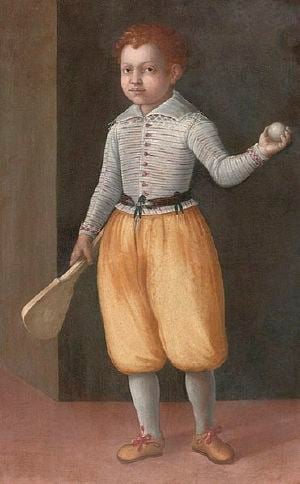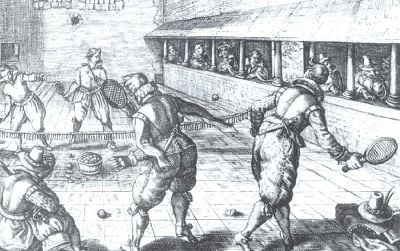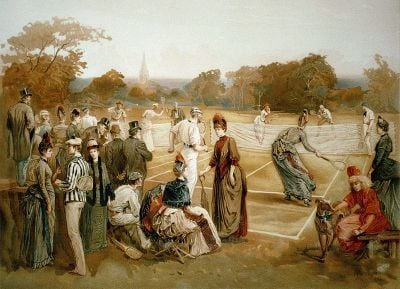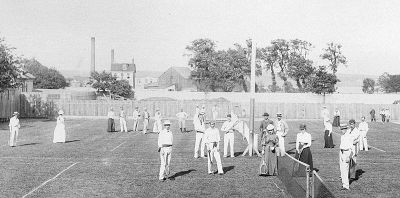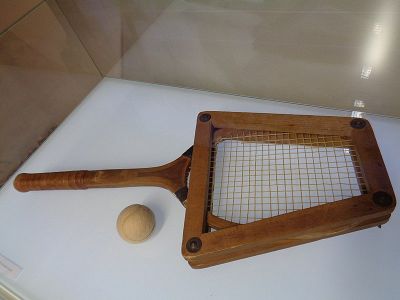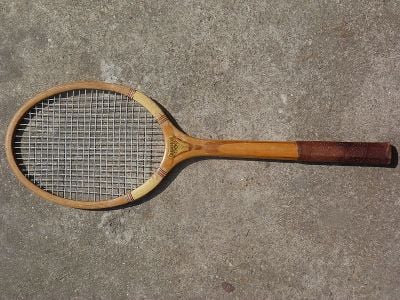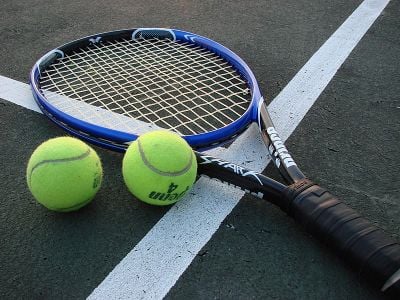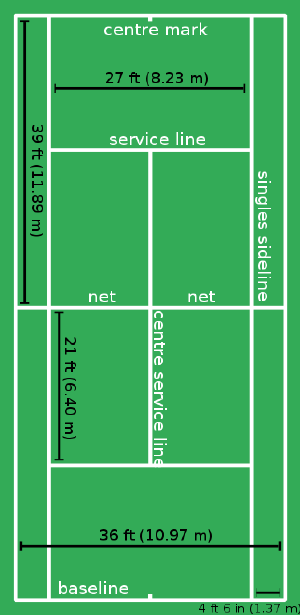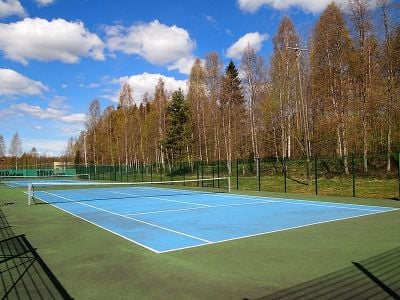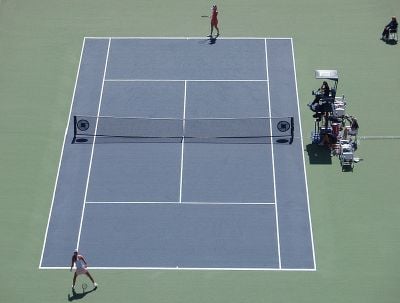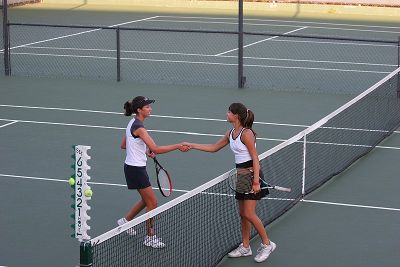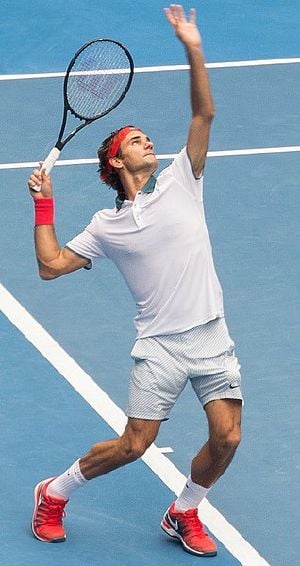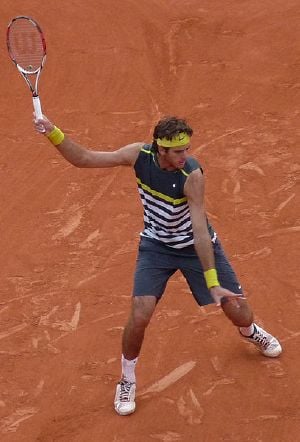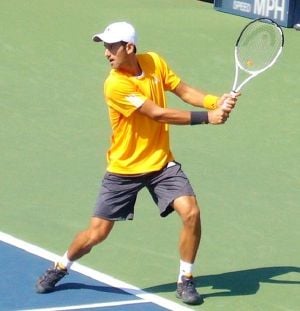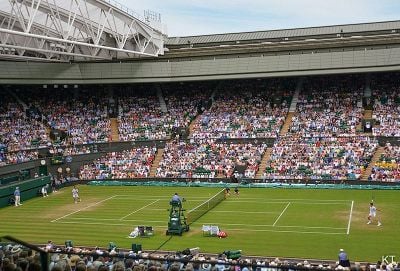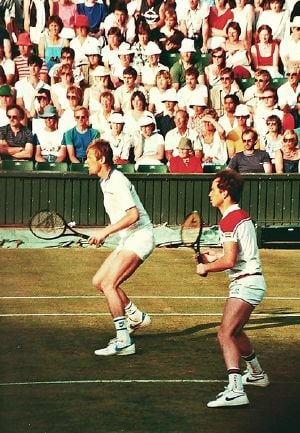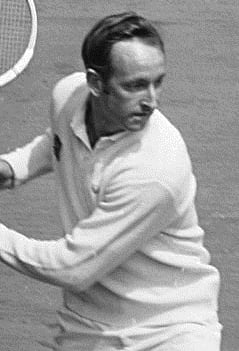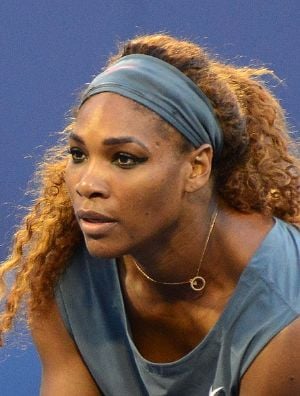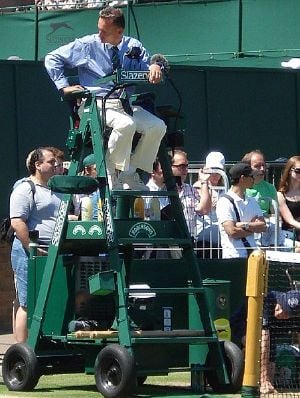Tennis
| Tennis | |
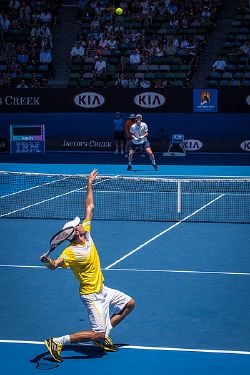
| |
| French singles player Guillaume Rufin serves to Czech player Tomáš Berdych in a tennis match at the 2013 Australian Open | |
| Highest governing body | International Tennis Federation |
| First played | Nineteenth century, Birmingham, England, United Kingdom |
| Characteristics | |
| Contact | No |
| Team Members | Singles or doubles |
| Mixed Gender | Yes, separate tours and mixed doubles |
| Category | Racket sport |
| Olympic | Part of Summer Olympic program from 1896 to 1924 Demonstration sport in the 1968 and 1984 Summer Olympics Part of Summer Olympic program since 1988 |
Tennis is a racket sport that is played either individually against a single opponent (singles) or between two teams of two players each (doubles). Each player uses a tennis racket (or racquet) that is strung with cord to strike a hollow rubber ball covered with felt over or around a net and into the opponent's court. The object of the game is to maneuver the ball in such a way that the opponent is not able to play a valid return. The player who is unable to return the ball validly will not gain a point, while the opposite player will. The sport can be played by anyone who can hold a racket, including wheelchair users.
Tennis is an Olympic sport and is played at all levels of society and at all ages. As well as being played by millions of recreational players, it is a popular worldwide spectator sport. The four Major championship tournaments (also referred to as the Grand Slam) are especially popular: the Australian Open, played on hard courts; the French Open, played on red clay courts; Wimbledon, played on grass courts; and the US Open, also played on hard courts.
History
The original forms of tennis developed in France during the late Middle Ages. The modern form of tennis originated in Birmingham, England, in the late nineteenth century as lawn tennis. It had close connections both to various field (lawn) games such as croquet and bowls as well as to the older racquet sport today called real tennis.
Predecessors
Historians believe that the game's ancient origin lay in twelfth-century northern France, where a ball was struck with the palm of the hand, known as Jeu de paume or "game of the hand," although racquets were eventually introduced and it evolved into real tennis.[1] Louis X of France was a keen player of jeu de paume and, unhappy with playing tennis outdoors, was the first to have indoor, enclosed courts constructed in Paris, "around the end of the 13th century."[2] In due course this design spread across royal palaces all over Europe.[2]
In June 1316 at Vincennes, Val-de-Marne, following a particularly exhausting game King Louis drank a large quantity of cooled wine and subsequently died of either pneumonia or pleurisy, although there was also suspicion of poisoning. Because of the contemporary accounts of his death, Louis X is history's first tennis player known by name.[1]
Another of the early enthusiasts of the game was King Charles V of France, who had a court set up at the Louvre Palace.[3]
It was not until the sixteenth century that rackets came into use and the game began to be called "tennis," from the French term tenez, which can be translated as "hold!", "receive!" or "take!", an interjection used as a call from the server to his opponent.[4] It was popular in England and France, although the game was only played indoors, where the ball could be hit off the wall. Henry VIII of England was a fan of this game, which is now known as real tennis.[5]
Origins of the modern game
The modern form of tennis originated in Birmingham, England, in the late nineteenth century as lawn tennis.[6] It had close connections both to various field (lawn) games such as croquet and bowls as well as to the older racket sport today called real tennis.
Between 1859 and 1865 Harry Gem, a solicitor, and his friend Augurio Perera developed a game that combined elements of racquets and the Basque ball game pelota, which they played on Perera's croquet lawn in Birmingham.[7] In 1872, along with two local doctors, Drs. Haynes and Tomkins, they founded the world's first tennis club on Avenue Road, Leamington Spa.[8] This is where "lawn tennis" was used as the name of an activity by a club for the first time.
On December 8, 1874, British army officer Walter Clopton Wingfield wrote to Harry Gem, commenting that he (Wingfield) had been experimenting with his version of lawn tennis "for a year and a half."[1] In December 1873, Wingfield designed and patented a game which he called sphairistikè (Greek: σφαιριστική, meaning "ball-playing"), and which was soon known simply as "sticky" – for the amusement of guests at a garden party on his friend's estate of Nantclwyd Hall, in Llanelidan, Wales.[9] According to R. D. C. Evans, turfgrass agronomist, "Sports historians all agree that [Wingfield] deserves much of the credit for the development of modern tennis."[10] Wingfield popularized the game through a brilliant marketing strategy:
Mindful of the growingly affluent middle classes in Victorian England who could afford houses with lawns for an after-lunch game of croquet, Wingfield saw an opportunity to resurrect medieval tennis in a modern form. So he put two poles, a net, a mallet, some pegs, four racquets, a handful of rubber balls, and an instruction manual into a box, and marketed it to those who wanted to expend a bit more energy after a hearty lunch than simply knocking a ball through a rectangular hoop. [11]
The world's oldest annual tennis tournament took place at Leamington Lawn Tennis Club in Birmingham in 1874.[1] This was three years before the All England Lawn Tennis and Croquet Club would hold its first championships at Wimbledon, in 1877.
In the United States in 1874, Mary Ewing Outerbridge, a young socialite, returned from Bermuda with a sphairistikè set. She became fascinated by the game of tennis after watching British army officers play.[12] She laid out a tennis court at the Staten Island Cricket Club at Camp Washington, Tompkinsville, Staten Island, New York. The first American National championship was played there in September 1880. An Englishman named O.E. Woodhouse won the singles title, and a silver cup worth $100, by defeating Canadian I. F. Hellmuth.[13] There was also a doubles match which was won by a local pair. At that time, there were different rules at each club; the ball in Boston was larger than the one normally used in New York.
Organizations Established
On May 21, 1881, the oldest nationwide tennis organization in the world was formed,[1] the United States National Lawn Tennis Association (now the United States Tennis Association) in order to standardize the rules and organize competitions.[14] The US National Men's Singles Championship, now the US Open, was first held in 1881 at the Newport Casino, Newport, Rhode Island.[14] The US National Women's Singles Championships were first held in 1887 in Philadelphia.[15]
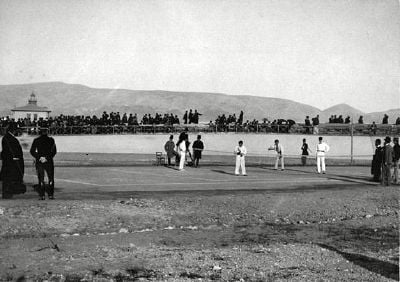
Tennis also became popular in France, where the French Championships date to 1891, although until 1925 they were open only to tennis players who were members of French clubs.[16] Thus, Wimbledon, the US Open, the French Open, and the Australian Open (dating to 1905) became and have remained the most prestigious events in tennis. Together, these four events are called the Majors or Slams (a term borrowed from contract bridge rather than baseball and entering the sports lexicon via golf).[17]
In 1913 in Paris, the International Lawn Tennis Federation (ILTF), now the International Tennis Federation (ITF), was founded with fifteen nations as the inaugural members. The World Grass Court Championships were awarded to Great Britain. At its AGM in 1923 the ILTF was appointed governor of the rules of tennis worldwide, with effect from January 1, 1924. At the same time, a new category of Official Championships was created for events in Great Britain, France, USA and Australia – today’s Grand Slam events.[18]
The comprehensive rules promulgated in 1924 by the ILTF have remained largely stable. The one major change being the addition of the tiebreak system designed by Jimmy Van Alen in 1958 to end marathon sets and matches, but only used in majors beginning in 1970 at the US Open.[19] That same year, tennis withdrew from the Olympics after the 1924 Games, but returned 60 years later as a 21-and-under demonstration event in 1984. This reinstatement was credited by the efforts of then ITF president Philippe Chatrier, ITF general secretary David Gray, and others who lobbied the International Olympic Committee (IOC) on tennis’ behalf.[20] The success of the event was overwhelming, and the IOC decided to reintroduce tennis as a full-medal sport at Seoul in 1988.[18]
The Davis Cup, an annual competition between men's national teams, dates to 1900.[21] The analogous competition for women's national teams, the Fed Cup, was founded as the Federation Cup in 1963 to celebrate the 50th anniversary of the founding of the ITF.[18]
In 1926, promoter C. C. Pyle established the first professional tennis tour with a group of American and French tennis players playing exhibition matches to paying audiences.> The most notable of these early professionals were the American Vincent Richards and the Frenchwoman Suzanne Lenglen. Players turned pro, were not permitted to compete in the major (amateur) tournaments until 1968.[22]
In 1968, the Open Era was inaugurated, in which all players could compete in all tournaments, and top players were able to make their living from tennis.[23] With the beginning of the Open Era, the establishment of an international professional tennis circuit, and revenues from the sale of television rights, tennis has become popular worldwide.
Equipment
Part of the appeal of tennis stems from the simplicity of equipment required for play. Beginners need only a racket and balls.[24]
Rackets
The components of a tennis racket include a handle, known as the grip, connected to a neck which joins a roughly elliptical frame that holds a matrix of tightly pulled strings. For the first 100 years of the modern game, rackets were made of wood and of standard size, and strings were of animal gut. Laminated wood construction yielded more strength in rackets used through most of the twentieth century, until first metal and then composites of carbon graphite, ceramics, and lighter metals such as titanium were introduced. These stronger materials enabled the production of oversized rackets that yielded yet more power. Meanwhile, technology led to the use of synthetic strings that match the feel of gut yet with added durability.
The rules regarding rackets have changed over time, as material and engineering advances have been made.
Strings
There are multiple types of tennis strings, including natural gut and synthetic stings made from materials such as nylon, kevlar, or polyester[25]
Natural gut
The first type of tennis strings available were natural gut strings, introduced by Babolat. They were the only type used until synthetic strings were introduced in the 1950s. They are made from cow intestines, and provide increased power, and are easier on the arm than most strings.[26]
Synthetic
Most synthetic strings are made from monofilament or multifiliament nylon strings. Monofilament strings are cheap to buy, and are used widely by many recreational level players for their all round performance, while multifilament strings are created to mimic natural gut more closely by weaving together fibers, but are generally more expensive than their monofilament counterparts.[25] Polyester strings allow for more spin on the ball than any other string, due to their firm strings, while keeping control of the ball, and this is why many advanced level players use them. Since polyester strings are quite firm feeling, they are generally not a good choice for players who are struggling with arm problems.[27]
Hybrid strings
Hybrid stringing is when a tennis racket is strung with two different strings for the mains (the vertical strings) and the crosses (the horizontal strings). This is most commonly done with two different strings that are made of different materials, but can also be done with two different types of the same string.
Balls
Tennis balls were originally made of cloth strips stitched together with thread and stuffed with feathers.[12] Modern tennis balls are made of hollow vulcanized rubber with a felt coating. Traditionally white, the predominant color was gradually changed to optic yellow in the latter part of the twentieth century to allow for improved visibility. Tennis balls must conform to certain criteria for size, weight, deformation, and bounce to be approved for regulation play.
Tennis balls were traditionally manufactured in the United States and Europe. Although the process of producing the balls has remained virtually unchanged for the past 100 years, the majority of manufacturing now takes place in the Far East where the cost of labor and materials is lower. Tournaments that are played under the International Tennis Federation (ITF) Rules of Tennis must use balls that are approved by the ITF and be named on the official ITF list of approved tennis balls.
Manner of play
Court
Tennis is played on a rectangular, flat surface. The court is 78 feet (23.77 m) long, and 27 feet (8.2 m) wide for singles matches and 36 ft (11 m) for doubles matches.[28] Additional clear space around the court is required in order for players to reach overrun balls. A net is stretched across the full width of the court, parallel with the baselines, dividing it into two equal ends. It is held up by either a cord or metal cable of diameter no greater than 0.8 cm (0.31 in). The net is 3 feet 6 inches (1.1 m) high at the posts and 3 feet (0.91 m) high in the center. The net posts are 3 feet (0.91 m) outside the doubles court on each side or, for a singles net, 3 feet (0.91 m) outside the singles court on each side.[28]
The modern tennis court owes its design to Major Walter Clopton Wingfield. In 1873, Wingfield patented a court much the same as the current one for his stické tennis (sphairistike). This template was modified in 1875 to the court design that exists today, with markings similar to Wingfield's version, but with the hourglass shape of his court changed to a rectangle.[9]
Tennis is unusual in that it is played on a variety of surfaces. Grass, clay, and hard courts of concrete or asphalt topped with acrylic are the most common. Occasionally carpet is used for indoor play, with hardwood flooring having been historically used. Artificial turf courts can also be found.
Lines
The lines that delineate the width of the court are called the baseline (farthest back) and the service line (middle of the court). The short mark in the center of each baseline is referred to as either the hash mark or the center mark. The outermost lines that make up the length are called the doubles sidelines; they are the boundaries for doubles matches. The lines to the inside of the doubles sidelines are the singles sidelines, and are the boundaries in singles play. The area between a doubles sideline and the nearest singles sideline is called the doubles alley, playable in doubles play. The line that runs across the center of a player's side of the court is called the service line because the serve must be delivered into the area between the service line and the net on the receiving side.[28] Despite its name, this is not where a player stands when making a serve.
The line dividing the service line in two is called the center line or center service line. The boxes this center line creates are called the service boxes; depending on a player's position, they have to hit the ball into one of these when serving. A ball is out only if none of it has hit the area inside the lines, or the line, upon its first bounce. All lines are required to be between 1 and 2 inches (25 and 51 mm) in width, with the exception of the baseline which can be up to 4 inches (100 mm) wide, although in practice it is often the same width as the others.[28]
Play of a single point
The players or teams start on opposite sides of the net. One player is designated the server, and the opposing player is the receiver. The choice to be server or receiver in the first game and the choice of ends is decided by a coin toss before the warm-up starts. Service alternates game by game between the two players or teams. For each point, the server starts behind the baseline, between the center mark and the sideline. The receiver may start anywhere on their side of the net. When the receiver is ready, the server will serve, although the receiver must play to the pace of the server.
For a service to be legal, the ball must travel over the net without touching it into the diagonally opposite service box. If the ball hits the net but lands in the service box, this is a let or net service, which is void, and the server retakes that serve. The player can serve any number of let services in a point and they are always treated as voids and not as faults. A fault is a serve that falls long or wide of the service box, or does not clear the net. There is also a "foot fault" when a player's foot touches the baseline or an extension of the center mark before the ball is hit. If the second service, after a fault, is also a fault, the server double faults, and the receiver wins the point. However, if the serve is in, it is considered a legal service.
A legal service starts a rally, in which the players alternate hitting the ball across the net. A legal return consists of a player hitting the ball so that it falls in the server's court, before it has bounced twice or hit any fixtures except the net. A player or team cannot hit the ball twice in a row. The ball must travel over or round the net into the other players' court. A ball that hits the net during a rally is considered a legal return as long as it crosses into the opposite side of the court. The first player or team to fail to make a legal return loses the point. The server then moves to the other side of the service line at the start of a new point.[29]
Scoring
Game
A game consists of a sequence of points played with the same player serving. A game is won by the first player to have won at least four points in total and at least two points more than the opponent. The running score of each game is described in a manner peculiar to tennis: scores from zero to three points are described as "love," "15," "30," and "40," respectively. If at least three points have been scored by each player, making the player's scores equal at 40 apiece, the score is not called out as "40–40," but rather as "deuce." If at least three points have been scored by each side and a player has one more point than his opponent, the score of the game is "advantage" for the player in the lead.
The score of a tennis game during play is always read with the serving player's score first. In tournament play, the chair umpire calls the point count (e.g., "15–love") after each point. At the end of a game, the chair umpire also announces the winner of the game and the overall score.[29]
Set
A set consists of a sequence of games played with service alternating between games, ending when the count of games won meets certain criteria. Typically, a player wins a set by winning at least six games and at least two games more than the opponent. If one player has won six games and the opponent five, an additional game is played. If the leading player wins that game, the player wins the set 7–5. If the trailing player wins the game (tying the set 6–6) a tiebreak is played. A tiebreak, played under a separate set of rules, allows one player to win one more game and thus the set, to give a final set score of 7–6. A tiebreak game can be won by scoring at least seven points and at least two points more than the opponent. The final score in sets is always read with the winning player's score first, e.g. "6–2, 4–6, 6–0, 7–5."
Match
A match consists of a sequence of sets. The outcome is determined through a best of three or five sets system. On the professional circuit, men play best-of-five-set matches at all four major tournaments, Davis Cup, and the final of the Olympic Games, and best-of-three-set matches at all other tournaments, while women play best-of-three-set matches at all tournaments. The first player to win two sets in a best-of-three, or three sets in a best-of-five, wins the match.
In tournament play, the chair umpire announces the end of the match with the well-known phrase "Game, set, match" followed by the winning person's or team's name.
Tiebreaks
- Standard tiebreak
At a score of six all, the set is determined by one more game called a "tiebreaker" (or just "tiebreak"). Only one more game is played to determine the winner of the set. Points are counted using ordinary numbering. The player who would normally be serving after 6–6 is the one to serve first in the tiebreak. After the first point, the serve changes to the first server's opponent. Each player then serves two consecutive points for the remainder of the tiebreak. After every six points, the players switch ends of the court; note that the side-changes during the tiebreak will occur in the middle of a server's two-point sequence. The set is won by the player who has scored at least seven points in the tiebreak and at least two points more than their opponent. The score of the resulting completed set is 7–6 or 6–7.
- Match tiebreak
A match tiebreak (also called super tiebreak) is played like a regular tiebreak, but the winner must win ten points instead of seven. In March 2022, the ATP, WTA, and ITF announced that final-set tiebreaks in all Major tournaments would have a 10-point tie break when the set reached six games all (6-6). The Olympics followed suit, beginning in 2024.
Match play
Continuity
A tennis match is intended to be continuous. Because stamina is a relevant factor, arbitrary delays are not permitted. In most cases, service is required to occur no more than 20 seconds after the end of the previous point. This is increased to 90 seconds when the players change ends (after every odd-numbered game), and a 2-minute break is permitted between sets. Other than this, breaks are permitted only when forced by events beyond the players' control, such as rain, damaged footwear, damaged racket, or the need to retrieve an errant ball. Should a player be deemed to be stalling repeatedly, the chair umpire may initially give a warning followed by subsequent penalties of "point," "game," and default of the match for the player who is consistently taking longer than the allowed time limit.
In the event of a rain delay, darkness, or other external conditions halting play, the match is resumed at a later time, with the same score as at the time of the delay, and each player at the same end of the court as when rain halted play, or as close to the same relative compass point if play is resumed on a different court.
Ball changes
Balls wear out quickly in serious play and, therefore, in ATP and WTA tournaments, they are changed after every nine games with the first change occurring after only seven games, because the first set of balls is also used for the pre-match warm-up. In ITF tournaments like Fed Cup, the balls are changed after every eleven games (rather than nine) with the first change occurring after only nine games (instead of seven). An exception is that a ball change may not take place at the beginning of a tiebreaker, in which case the ball change is delayed until the beginning of the second game of the next set. As a courtesy to the receiver, the server will often signal to the receiver before the first serve of the game in which new balls are used as a reminder that they are using new balls. Continuity of the balls' condition is considered part of the game, so if a re-warm-up is required after an extended break in play (usually due to rain), then the re-warm-up is done using a separate set of balls, and use of the match balls is resumed only when play resumes.
On-court and off-court coaching
The line between encouragement and coaching during a tennis match has been difficult to define, and infringements have generally gone unenforced. A number of attempts to resolve this conundrum have occurred.
Coaching on-court on a limited basis during a match was introduced in 1998 in some tournaments, but quickly abandoned.[30] It was been introduced in women's tennis for WTA Tour events, allowing the player to request her coach once per set.[31]
"Off-court coaching" was accepted on a trial basis during the second half of the 2022 season, including at the US Open. Coaches were required to remain in their designated seats, and were allowed to give verbal coaching when the player was on the same side of the court as their coach.[32]
Stance
Stance refers to the way a player prepares themselves in order to best be able to return a shot. Essentially, it enables them to move quickly in order to achieve a particular stroke. There are four main stances in modern tennis: open, semi-open, closed, and neutral. All four stances involve the player crouching in some manner: as well as being a more efficient striking posture, it allows them to isometrically preload their muscles in order to play the stroke more dynamically. What stance is selected is strongly influenced by shot selection. A player may quickly alter their stance depending on the circumstances and the type of shot they intend to play. Any given stance also alters dramatically based upon the actual playing of the shot with dynamic movements and shifts of body weight occurring.[33]
Shots
A competent tennis player has eight basic shots in his or her repertoire: the serve, forehand, backhand, volley, half-volley, overhead smash, drop shot, and lob.
Grip
Grip is the way of holding the racket in order to hit shots during a match. The grip affects the angle of the racket face when it hits the ball and influences the pace, spin, and placement of the shot. Players use various grips during play, including the Continental (The "Handshake Grip"), Eastern (Can be either semi-eastern or full eastern. Usually used for backhands), and Western (semi-western or full western, usually for forehands) grips. Most players change grips during a match depending on what shot they are hitting; for example, slice shots, and serves call for a Continental grip.[34]
Serve
A serve (or, more formally, a "service") in tennis is a shot to start a point. The serve is initiated by tossing the ball into the air and hitting it (usually near the apex of its trajectory) into the diagonally opposite service box without touching the net. If the ball hits the net on the first serve and bounces over into the correct diagonal box then it is called a "let."
The service is a let if:
a. The ball served touches the net, strap or band, and is otherwise good; or,
after touching the net, strap or band, touches the receiver or the receiver’s partner or anything they wear or carry before hitting the ground; or
b. The ball is served when the receiver is not ready. In the case of a service let, that particular service shall not count, and the server shall serve again, but a service let does not cancel a previous fault.[35]
The serve may be hit under- or overhand, although underhand serving remains a rarity.[36] Experienced players strive to master the conventional overhand serve to maximize its power and placement. The server may employ different types of serve including flat serve, topspin serve, slice serve, and kick (American twist) serve. A reverse type of spin serve is hit in a manner that spins the ball opposite the natural spin of the server, the spin direction depending upon right- or left-handedness. If the ball is spinning counterclockwise, it will curve right from the hitter's point of view and curve left if spinning clockwise.[37]
Some servers are content to use the serve simply to initiate the point; however, advanced players often try to hit a winning shot with their serve. A winning serve that is not touched by the opponent is called an "ace."
Forehand
For a right-handed player, the forehand is a stroke that begins on the right side of the body, continues across the body as contact is made with the ball, and ends on the left side of the body. There are various grips for executing the forehand, but no matter which grip is used, most forehands are generally executed with one hand holding the racket. However, there have been fine players with two-handed forehands. In the 1940s and 1950s, the Ecuadorian/American player Pancho Segura used a two-handed forehand to achieve a devastating effect against larger, more powerful players. Players such as Monica Seles or France's Fabrice Santoro and Marion Bartoli are also notable players known for their two-handed forehands.[38]
Backhand
For right-handed players, the backhand is a stroke that begins on the left side of their body, continues across their body as contact is made with the ball, and ends on the right side of their body. It can be executed with either one hand or with both and is generally considered more difficult to master than the forehand. Two hands give the player more control, while one hand can generate a slice shot, applying backspin on the ball to produce a low trajectory bounce. Reach is also limited with the two-handed shot.
For most of the twentieth century, the backhand was performed with one hand, using either an eastern or a continental grip. Don Budge, in the 1930s and 1940s, had a powerful one-handed backhand stroke that imparted topspin onto the ball. Ken Rosewall, another player noted for his one-handed backhand, used a very accurate slice backhand through the 1950s and 1960s.
The first notable players to use two hands were the 1930s Australians Vivian McGrath and John Bromwich, but they were exceptions. The two-handed grip gained popularity in the 1970s as Björn Borg, Chris Evert, Jimmy Connors, and later Mats Wilander and Marat Safin used it to great effect, and has recently been used by a large number of the world's best players, including Novak Djokovic, Rafael Nadal, and Serena Williams.[39]
Other shots
A volley is a shot returned to the opponent in mid-air before the ball bounces, generally performed near the net, and is usually made with a stiff-wristed punching motion to hit the ball into an open area of the opponent's court. The half volley is made by hitting the ball on the rise just after it has bounced, also generally in the vicinity of the net, and played with the racket close to the ground.[40] The swinging volley is hit out of the air as the player approaches the net. It is an offensive shot used to take preparation time away from the opponent, as it returns the ball into the opponent's court much faster than a standard volley.
From a poor defensive position on the baseline, the lob can be used as either an offensive or defensive weapon, hitting the ball high and deep into the opponent's court to either enable the lobber to get into better defensive position or to win the point outright by hitting it over the opponent's head. If the lob is not hit deeply enough into the other court, however, an opponent near the net may then hit an overhead smash, a hard, serve-like shot, to try to end the point.
If their opponent is deep in their court, a player may suddenly employ an unexpected drop shot, by softly tapping the ball just over the net so that the opponent is unable to run in fast enough to retrieve it. Advanced players will often apply back spin to a drop shot, causing the ball to "skid" upon landing and bounce sideways, with less forward momentum toward their opponent, or even backwards towards the net, thus making it even more difficult to return.
Tournaments
Tournaments are often organized by gender and number of players. Common tournament configurations include men's singles, women's singles, and doubles, where two players play on each side of the net, both men, both women, or mixed. Tournaments may be organized for specific age groups, with upper age limits for youth and lower age limits for senior players. There are also tournaments for players with disabilities, such as wheelchair tennis[41] and deaf tennis.[42] In the four major tournaments, the singles draws are limited to 128 players for each gender.
Most large tournaments seed players, based on their ranking points received for their performance at tournaments during the year.
Major tournaments
The four Major tournaments, also known as "Grand Slam" tournaments, are considered to be the most prestigious tennis events in the world. They are held annually and comprise, in chronological order, the Australian Open, the French Open, Wimbledon, and the US Open. Winning all four in one year is known as a Grand Slam. Apart from the Olympic Games, Davis Cup, Fed Cup, and Hopman Cup, they are the only tournaments regulated by the International Tennis Federation (ITF). The ITF's national associations, Tennis Australia (Australian Open), the Fédération Française de Tennis (French Open), the Lawn Tennis Association (Wimbledon) and the United States Tennis Association (US Open) are delegated the responsibility to organize these events.[43]
Aside from the historical significance of these events, they also carry larger prize funds than any other tour event and are worth double the number of ranking points to the champion than in the next echelon of tournaments, the ATP Masters 1000 (men) and Premier events (women).[44]
Another distinguishing feature is the number of players in the singles draw. There are 128, more than any other professional tennis tournament. This draw is composed of 32 seeded players, other players ranked in the world's top 100, qualifiers, and players who receive invitations through wild cards. Grand Slam men's tournaments have best-of-five set matches while the women play best-of-three. Grand Slam tournaments are among the small number of events that last two weeks, the others being the Indian Wells Masters and the Miami Masters.
Currently, the Major tournaments are the only tour events that have mixed doubles contests. These tournaments are held in conjunction with wheelchair tennis tournaments and junior tennis competitions. The tournaments also contain their own idiosyncrasies. For example, players at Wimbledon are required to wear predominantly white which famously led Andre Agassi to skip Wimbledon from 1988 through 1990 citing as his reason its "predominantly white" dress code.[45]
| Grand Slam | First held | Location | Surface | Date | Prize money |
|---|---|---|---|---|---|
| Australian Open | 1905 | Melbourne | Hard | January–February | A$75,000,000 (2022) |
| French Open | 1891* | Paris | Clay | May–June | €42,661,000 (2022) |
| Wimbledon | 1877 | London | Grass | June–July | £40,350,000 (2022) |
| US Open | 1881 | New York City | Hard | August–September | US$57,462,000 (2021) |
- The international tournament began in 1925.
Men's tournament structure
Masters Series
The ATP Masters 1000, formerly called the ATP Masters Series, is a group of nine tournaments that form the second-highest echelon in men's tennis. Each event is held annually, and a win at one of these events is worth 1000 ranking points. In November at the end of the tennis year, the world's top eight players compete in the ATP Finals, a tournament with a rotating locale.
500 and 250 series
The third and fourth tier of men's tennis tournaments are formed by the ATP 500 series, consisting of 11 tournaments, and the ATP 250 series with 40 tournaments.[46] Like the ATP Masters 1000, these events offer various amounts of prize money and the numbers refer to the number of ranking points earned by the winner of a tournament.[44] These series have various draws of 28, 32, 48, and 56 for singles and 16 and 24 for doubles. It is mandatory for leading players to enter at least four 500 events, including at least one after the US Open.
Challenger Tour
The Challenger Tour for men is the lowest level of tournament administered by the ATP. It is composed of about 150 events and, as a result, features a more diverse range of countries hosting events.[47] The majority of players use the Challenger Series at the beginning of their career to work their way up the rankings.
Futures tournaments
Below the Challenger Tour are the Futures tournaments, events on the ITF Men's Circuit. These tournaments also contribute towards a player's ATP rankings points, enabling professionals to progress to the ATP Challenger Tour and ATP Tour, and ultimately the Grand Slams. The Tour offers approximately 550 tournaments across 70 countries and incorporates two prize money levels of tournaments: $15,000 and $25,000.[48]
Women's tournament structure
In 2021, the WTA rebranded, resembling the men's tournament series, and also providing extra simplicity for fans and consumers. The numbers do not indicate ranking points, or prize money, but is a system to help define different levels of women's tennis.
WTA 1000
The WTA 1000 Tournaments (formerly the Premier Mandatory and Premier 5 Tournaments), are a series of seven tournaments that are part of the second-highest tier in women's tennis.
500 and 250 Series
The third and fourth tier of women's tennis tournaments are formed from the WTA 500 Series (formerly Premier 700), with fifteen tournaments, and the WTA 250 Series (formerly International), consisting of thirty tournaments.[49]
WTA 125
The WTA 125 Series (formerly 125K Series), is the lowest tier of women's tennis, with fourteen tournaments.[49]
Junior tennis
To succeed in tennis often means having to begin playing at a young age. To facilitate and nurture a junior's growth in tennis, almost all tennis playing nations have developed a junior development system. Juniors, players under 18 still legally protected by a parent or guardian, develop their play through a range of tournaments on all surfaces, accommodating all different standards of play. Talented juniors may also receive sponsorships from governing bodies or private institutions.
The International Tennis Federation (ITF) conducts a junior tour that allows juniors to establish a world ranking and an Association of Tennis Professionals (ATP) or Women's Tennis Association (WTA) ranking. Most juniors who enter the international circuit do so by progressing through ITF, Satellite, Future, and Challenger tournaments before entering the main circuit. The latter three circuits also have adults competing in them.
Junior tournaments do not offer prize money except for the Grand Slam tournaments, which are the most prestigious junior events. Juniors may earn income from tennis by participating in the Future, Satellite, or Challenger tours. Leading juniors are allowed to participate for their nation in the Junior Fed Cup and Davis Cup competitions.
Professional players
Professional tennis players enjoy the same relative perks as most top sports personalities: clothing, equipment, and endorsements. Like players of other individual sports such as golf, they are not salaried, but must play and finish highly in tournaments to obtain prize money.
While players are gradually less competitive in singles by their 30s, they can still continue competitively in doubles (as instanced by Martina Navratilova and John McEnroe, who won doubles titles in their 40s).
In the Open Era, several female players such as Martina Navratilova, Margaret Court, Martina Hingis, Serena Williams, and Venus Williams (the latter two sisters playing together) were prolific at both singles and doubles events throughout their careers. John McEnroe is one of the very few professional male players to be top ranked in both singles and doubles at the same time.[50]
In terms of public attention and earnings, singles champions have far surpassed their doubles counterparts. The Open Era, particularly the men's side, has seen many top-ranked singles players that only sparingly compete in doubles, while having "doubles specialists" who are typically being eliminated early in the singles draw but do well in the doubles portion of a tournament. Notable doubles pairings include The Woodies (Todd Woodbridge and Mark Woodforde) and the Bryan Brothers (identical twin brothers Robert Charles "Bob" Bryan and Michael Carl "Mike" Bryan).
In professional tennis tournaments such as Wimbledon, the singles competition receives the most prize money and coverage, followed by doubles, and mixed doubles usually receive the lowest monetary awards.
Outstanding players
While the "greatest" player changes as the game changes, several players have remained outstanding in the tennis world. For example, several male and female players have been honored by having a tennis stadium named after them: in the United States, the USTA Billie Jean King National Tennis Center and its main court the Arthur Ashe Stadium are named after American players Billie Jean King and Arthur Ashe; in Australia, the Margaret Court Arena and Rod Laver Arena are named after the Australian players, Margaret Court and Rod Laver; and in France, Court Philippe-Chatrier, Court Suzanne Lenglen, and Court Simonne-Mathieu are named after French players Philippe Chatrier, Suzanne Lenglen, and Simonne Mathieu.
- Greatest male players
A frequent topic of discussion among tennis fans and commentators is who was the greatest male singles player of all time. By a large margin, an Associated Press poll in 1950 named Bill Tilden as the greatest player of the first half of the twentieth century.[51] In 1938, however, Donald Budge became the first person to win all four major singles titles during the same calendar year, the Grand Slam, and won six consecutive major titles in 1937 and 1938.
Before and during the Open Era, Rod Laver remains the only male player in history to have won the calendar year Grand Slam twice in 1962 and 1969 and also the calendar year Professional Grand Slam in 1967.[52]
Andre Agassi was the first of two male players in history to have achieved a Career Golden Slam (winning all four Majors and the Olympic gold medal during their professional career) in singles tennis, followed by Rafael Nadal. Agassi was the first man to win grand slams on all modern surfaces (hard, grass, and clay court, as previous holders of all grand slam tournaments played in an era of grass and clay only). Both Rod Laver and Ken Rosewall also won major Pro Slam tournaments on all three surfaces (grass, clay, hard court) Rosewall in 1963 and Laver in 1967.
By the early twenty-first century, the "Big Three" of Roger Federer, Rafael Nadal, and Novak Djokovic dominated, each winning 20 or more grand slam titles.[53]
- Greatest female players
As with the men there are frequent discussions about who is the greatest female singles player of all time with Steffi Graf, Martina Navratilova, Margaret Court, and Serena Williams being the players most often nominated. Steffi Graf, directly followed by Martina Navratilova, have often been cited as the best female tennis players of the twentieth century.[54] Margaret Court's 24 major singles titles and total of 64 major titles (including 19 Grand Slam women's doubles and 21 Grand Slam mixed doubles titles) are the most in tennis history, while Serena Williams became the only singles player to achieve the Career Golden Slam in both singles and doubles with her singles gold at the 2012 London Olympics.
Officials
In most professional play and some amateur competition, there is an officiating head judge or chair umpire (usually referred to simply as the umpire), who sits in a raised chair to one side of the court. The umpire has absolute authority to make factual determinations. The umpire may be assisted by line judges, who determine whether the ball has landed within the required part of the court and who also call foot faults. There also may be a net judge who determines whether the ball has touched the net during service. The umpire has the right to overrule a line judge or a net judge if the umpire is sure that a clear mistake has been made.[55]
Line judges tasked with calling the serve were sometimes assisted by electronic sensors that beeped to indicate an out-of-bounds serve, such as "Cyclops"[56]and Hawk-Eye.[57] In professional tournaments using this system, players are allowed three unsuccessful appeals per set, plus one additional appeal in the tiebreak to challenge close line calls by means of an electronic review. In clay-court matches, such as at the French Open, a call may be questioned by reference to the mark left by the ball's impact on the court surface.
To reduce staff due to COVID-19 pandemic restrictions, the 2020 US Open employed electronic line judges on most matches, excluding those held at Arthur Ashe Stadium and Louis Armstrong Stadium. At the 2021 Australian Open, all matches used electronic line judges for the first time in a Grand Slam event.[58] In subsequent event, electronic line judges have been used exclusively, with a recording of a former line judge calling "Out," automated to make a call based on where the ball lands on the court.[59]
The referee, who is usually located off the court, is the final authority about tennis rules. When called to the court by a player or team captain, the referee may overrule the umpire's decision if the tennis rules were violated (question of law) but may not change the umpire's decision on a question of fact. If, however, the referee is on the court during play, the referee may overrule the umpire's decision. (This would only happen in Davis Cup or Fed Cup matches, not at the World Group level, when a chair umpire from a non-neutral country is in the chair).[55]
Injuries
Muscle strain is one of the most common injuries in tennis. When an isolated large-energy appears during the muscle contraction and at the same time body weight apply huge amount of pressure to the lengthened muscle, muscle strain can occur which triggers inflammation and bleeding, which can result in redness, pain, and swelling.[60] Overuse is also common in tennis players of all levels. Muscle, cartilage, nerves, bursae, ligaments, and tendons may be damaged from overuse. The repetitive use of a particular muscle without time for repair and recovery is the most common cause of injury.[60]
Notes
- ↑ 1.0 1.1 1.2 1.3 1.4 Heiner Gillmeister, Tennis: A Cultural History (Equinox Publishing, 2017, ISBN 978-1781795217).
- ↑ 2.0 2.1 Paul B. Newman, Daily life in the Middle Ages (McFarland & Company, 2001, ISBN 978-0786408979).
- ↑ John Moyer Heathcote, Tennis (Forgotten Books, 2017, ISBN 1333080220).
- ↑ tennis Online Etymology Dictionary. Retrieved November 5, 2024.
- ↑ Robert Crego, Sports and Games of the 18th and 19th Centuries (Greenwood, 2002, ISBN 978-0313316104).
- ↑ William J. Baker, Sports in the Western World (University of Illinois Press, 1988, ISBN 978-0252060427).
- ↑ Anna Tyzack, The True Home of Tennis Country Life, June 22, 2005. Retrieved November 5, 2024.
- ↑ Club History Leamington Lawn Tennis Club. Retrieved November 5, 2024.
- ↑ 9.0 9.1 E. M. Halliday, Sphairistiké, Anyone? American Heritage 22(4) (June 1971). Retrieved November 5, 2024.
- ↑ Jeffrey Perris, Grass Tennis Courts: How to construct and maintain them (Sports Turf Research Institute, 2000, ISBN 978-1873431344).
- ↑ Chris Bowers, Celebrating 150 Years of Tennis (As We Know It) International Tennis Hall of Fame, February 14, 2024. Retrieved November 5, 2024.
- ↑ 12.0 12.1 Will Grimsley, Tennis: Its History, People and Events (Prentice-Hall, 1971, ISBN 978-0139033773).
- ↑ Lawn-Tennis on Staten Island The New York Times, September 4, 1880. Retrieved November 5, 2024.
- ↑ 14.0 14.1 USTA History USTA. Retrieved November 5, 2024.
- ↑ US Open Tennis History Through The Years Tennis Location. Retrieved November 5, 2024.
- ↑ 126 Years of History Roland-Garros. Retrieved November 5, 2024.
- ↑ Randy Walker, The Grand Slam – Origins and Correct Verbiage World Tennis, June 27, 2015. Retrieved November 5, 2024.
- ↑ 18.0 18.1 18.2 History of the ITF International Tennis Federation (ITF). Retrieved November 5, 2024.
- ↑ Jimmy Van Alen International Tennis Hall of Fame. Retrieved November 5, 2024.
- ↑ Tennis and the Rio Olympics International Tennis Hall of Fame, August 5, 2016. Retrieved November 5, 2024.
- ↑ Davis Cup History. Davis Cup. Retrieved November 5, 2024.
- ↑ Ray Bowers, History of the Pro Tennis Wars, Chapter 2, part 1: 1927-1928 Tennis Server, March 1, 2001. Retrieved November 5, 2024.
- ↑ Jérémy Baudu, 1968, Open era: The moment tennis opted to become a modern sport Tennis Majors, May 8, 2020. Retrieved November 5, 2024.
- ↑ Tennis Rules: Players & Equipment Rules of Sport. Retrieved November 5, 2024.
- ↑ 25.0 25.1 Jon Crim, Types of Tennis Strings Tennis Companion. Retrieved November 5, 2024.
- ↑ Natural Gut Strings – The Best Tennis Strings Available? Perfect Tennis, April 14, 2022. Retrieved November 5, 2024.
- ↑ Pros and cons of polyester tennis strings Tennis Warehouse. Retrieved November 5, 2024.
- ↑ 28.0 28.1 28.2 28.3 Tennis Court Dimensions & Size Harrod Sport, March 27, 2020. Retrieved November 5, 2024.
- ↑ 29.0 29.1 Basic rules of tennis ActiveSG. Retrieved January 28, 2023.
- ↑ Chris Lewis, Tennis On-Court Coaching Should It Be Allowed? Expert Tennis Tips, May 16, 1998. Retrieved November 5, 2024.
- ↑ Bonnie DeSimone, Does on-court coaching have a future? ESPN, October 10, 2006. Retrieved November 5, 2024.
- ↑ Ed McGrogan, Coach's Corner Tennis, June 21, 2022. Retrieved November 5, 2024.
- ↑ Tennis Footwork: Different Hitting Stances Explained Improve Your Tennis. Retrieved November 5, 2024.
- ↑ Tennis Grip Guide: 4 Grips to Tighten up Your Tennis Game Master Class. Retrieved November 5, 2024.
- ↑ Part 1-ITF Rules of Tennis USTA. Retrieved November 5, 2024.
- ↑ Greg Garber, Chang refused to lose 20 years ago ESPN, May 19, 2009. Retrieved November 5, 2024.
- ↑ Serves BBC Sport: Tennis. Retrieved November 5, 2024.
- ↑ David W. Smith, The Two-handed Forehand Revisited TennisONE. Retrieved November 5, 2024.
- ↑ Two Handed Backhand Pros and Cons The Tennis Bros. Retrieved November 5, 2024.
- ↑ John Grasso, Historical Dictionary of Tennis (Scarecrow Press, 2011, ISBN 978-0810872370).
- ↑ Wheelchair tennis LTA. Retrieved November 5, 2024.
- ↑ Deaf Tennis LTA. Retrieved November 5, 2024.
- ↑ Grand Slam tournaments ITF. Retrieved November 5, 2024.
- ↑ 44.0 44.1 ATP Rankings FAQ ATP. Retrieved November 5, 2024.
- ↑ Sarah Holt, What not to wear at Wimbledon BBC Sport: Tennis, June 15, 2005. Retrieved November 5, 2024.
- ↑ Calendar ATP Tour. Retrieved November 5, 2024.
- ↑ ATP Challenger Tour Calendar ATP Tour. Retrieved November 5, 2024.
- ↑ ITF Men's World Tennis Tour ITF. Retrieved November 5, 2024.
- ↑ 49.0 49.1 Tournaments Calendar WTA. Retrieved November 5, 2024.
- ↑ Matthew Cronin, Epic: John McEnroe, Björn Borg, and the Greatest Tennis Season Ever (Wiley, 2011, ISBN 0470190620).
- ↑ Ron Borges, Tilden brought theatrics to tennis ESPN. Retrieved November 5, 2024.
- ↑ John Bercow, Tennis Maestros: The Twenty Greatest Male Tennis Players of All Time (Biteback Publishing Ltd, 2014, ISBN 978-1849545129).
- ↑ Charlie Eccleshare, Roger Federer, Rafael Nadal and Novak Djokovic head to US Open with 'Big Three' more dominant than ever The Telegraph, August 27, 2018. Retrieved November 5, 2024.
- ↑ Steven Flink, The Greatest Tennis Matches of the Twentieth Century (Netsource Dist Services, 1999, ISBN 978-1582440767).
- ↑ 55.0 55.1 ITF Rules of Tennis – Appendix VI (Role of Court Officials) ITF. Retrieved November 5, 2024.
- ↑ Cyclops and speed guns BBC Tennis. Retrieved November 5, 2024.
- ↑ Richard Evans, Hawk-eye vision The Guardian, June 27, 2009. Retrieved November 5, 2024.
- ↑ Jake Michaels, 'There are just no mistakes happening': Hawk-Eye Live gains more support at Australian Open ESPN, February 13, 2021. Retrieved November 5, 2024.
- ↑ Aishwarya Kumar, US Open: USTA has turned to automatic line judges — and the players love it ESPN, September 7, 2022. Retrieved November 5, 2024.
- ↑ 60.0 60.1 Pamela K. Levangie and Cynthia C. Norkin, Joint Structure and Function: A Comprehensive Analysis (F.A. Davis Company, 2011, ISBN 978-0803623620).
ReferencesISBN links support NWE through referral fees
- Baker, William J. Sports in the Western World. University of Illinois Press, 1988. ISBN 978-0252060427
- Barrett, John. Wimbledon: The Official History of the Championships. HarperCollins, 2001. ISBN 978-0007117079
- Bercow, John. Tennis Maestros: The Twenty Greatest Male Tennis Players of All Time. Biteback Publishing Ltd, 2014. ISBN 978-1849545129
- Collins, Bud. The Bud Collins History of Tennis. New Chapter Press, 2016. ISBN 978-1937559380
- Crego, Robert. Sports and Games of the 18th and 19th Centuries. Greenwood, 2002. ISBN 978-0313316104
- Cronin, Matthew. Epic: John McEnroe, Björn Borg, and the Greatest Tennis Season Ever. Wiley, 2011. ISBN 0470190620
- Everitt, Robert, and Richard Hillway. The Birth of Lawn Tennis: From the origin of the game to the first Championship at Wimbledon. Vision Sports Publishing, 2019. ISBN 978-1909534810
- Flink, Steven. The Greatest Tennis Matches of the Twentieth Century. Netsource Dist Services, 1999. ISBN 978-1582440767
- Gillmeister, Heiner. Tennis: A Cultural History. Equinox Publishing, 2017. ISBN 978-1781795217
- Grasso, John. Historical Dictionary of Tennis. Scarecrow Press, 2011. ISBN 978-0810872370
- Grimsley, Will. Tennis: Its History, People and Events. Prentice-Hall, 1971. ISBN 978-0139033773
- Heathcote, John Moyer. Tennis. Forgotten Books, 2017. ISBN 1333080220
- King, Billie Jean, and Cynthia Starr. We Have Come a Long Way: The Story of Women's Tennis. McGraw-Hill, 1988. ISBN 978-0070346253
- Levangie, Pamela K., and Cynthia C. Norkin. Joint Structure and Function: A Comprehensive Analysis. F.A. Davis Company, 2011. ISBN 978-0803623620
- Newman, Paul B. Daily life in the Middle Ages. McFarland & Company, 2001. ISBN 978-0786408979
- Perris, Jeffrey. Grass Tennis Courts: How to construct and maintain them. Sports Turf Research Institute, 2000. ISBN 978-1873431344
- Whitman, Malcolm D. Tennis: Origins and Mysteries. Dover Publications, 2004. ISBN 978-0486433578
External links
All links retrieved November 5, 2024.
- International Tennis Federation (ITF)
- Association of Tennis Players (ATP) – Men's professional tennis organization
- Women's Tennis Association (WTA) – Women's professional tennis organization
- International Tennis Hall of Fame
- Grand Slam history
- The Harry Gem Project
Credits
New World Encyclopedia writers and editors rewrote and completed the Wikipedia article in accordance with New World Encyclopedia standards. This article abides by terms of the Creative Commons CC-by-sa 3.0 License (CC-by-sa), which may be used and disseminated with proper attribution. Credit is due under the terms of this license that can reference both the New World Encyclopedia contributors and the selfless volunteer contributors of the Wikimedia Foundation. To cite this article click here for a list of acceptable citing formats.The history of earlier contributions by wikipedians is accessible to researchers here:
The history of this article since it was imported to New World Encyclopedia:
Note: Some restrictions may apply to use of individual images which are separately licensed.
